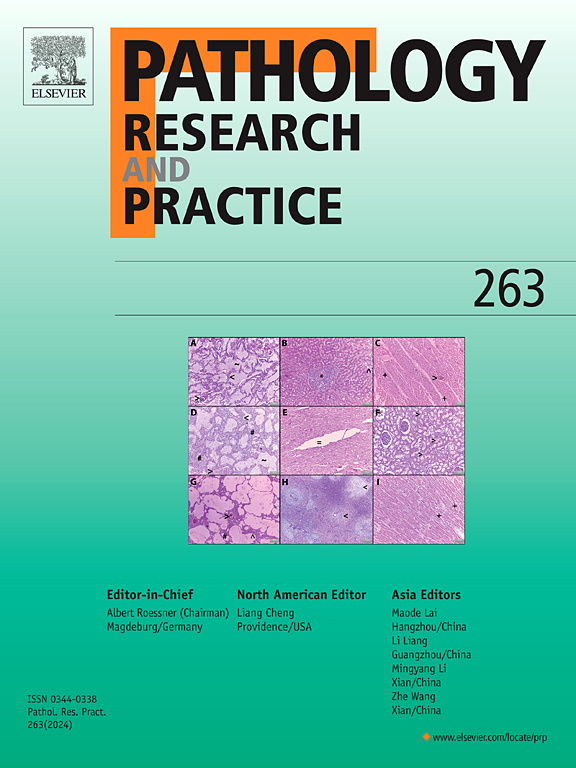靶向ATG12-ATG3蛋白蛋白相互作用:从自噬调节的结构见解到治疗机会
IF 3.2
4区 医学
Q2 PATHOLOGY
引用次数: 0
摘要
自噬维持细胞代谢,形成免疫信号,当失调时,有助于癌症进展和细胞因子风暴综合征。一个关键的催化步骤是微管相关蛋白1轻链3 (LC3)与磷脂酰乙醇胺的偶联,由e2样酶自噬相关蛋白3 (ATG3)与泛素样蛋白自噬相关蛋白12 (ATG12)的直接结合驱动。破坏这种ATG12-ATG3蛋白-蛋白相互作用(PPI)可以高选择性地抑制自噬的降解和分泌臂。在这里,我们回顾了ATG12-ATG3抑制从结构洞察力到药物样化学物质的快速演变。高分辨率晶体学确定了ATG12 Trp73周围的疏水袋,可容纳ATG3 Met157,揭示了“锚定-锁存”-一个基序,其中一个残基(“锚”)深埋,而侧翼残基(“锁存”)确保了小分子竞争理想的复杂拓扑结构。在硅口袋偏压的引导下,一个超过40,000种化合物的分裂高斯荧光素酶筛选产生了17个微摩尔干扰物;系统结构-活性关系(SAR)探索将脱靶酪蛋白激酶2 (CK2)转化为直接结合ATG12的萘先导化合物189(解离常数,KD≈5 µM)。这种铅在个位数的微摩尔浓度下使自噬通量崩溃,阻止自噬成瘾的肿瘤细胞并抑制巨噬细胞分泌白细胞介素-1β (IL-1β),这些都没有激酶或溶酶体的责任。从150多种类似物中提炼出来的药物化学原理定义了疏水“插头”、极性“爪”和控制效力和选择性的极性调节手柄。集成的分析工具箱-跨越表面等离子体共振(SPR),双色LC3通量报告和疾病相关表型-现在驱动纳米摩尔优化和安全性分析。我们总结了未来的发展方向:共价可逆化学型,靶向蛋白水解嵌合体(PROTAC)降解物,靶向递送平台和联合方案,准备将ATG12-ATG3破坏转化为肿瘤,免疫学和感染性疾病的一流治疗药物。本文章由计算机程序翻译,如有差异,请以英文原文为准。
Targeting the ATG12–ATG3 protein-protein interaction: From structural insights to therapeutic opportunities in autophagy modulation
Autophagy sustains cellular metabolism, shapes immune signaling and, when dysregulated, contributes to cancer progression and cytokine-storm syndromes. A crucial catalytic step is conjugation of microtubule-associated protein 1 light chain 3 (LC3) to phosphatidylethanolamine, driven by direct binding of the E2-like enzyme autophagy-related protein 3 (ATG3) to the ubiquitin-like protein autophagy-related protein 12 (ATG12). Disrupting this ATG12–ATG3 protein–protein interaction (PPI) could silence both the degradative and secretory arms of autophagy with high pathway selectivity. Here we review the rapid evolution of ATG12–ATG3 inhibition from structural insight to drug-like chemical matter. High-resolution crystallography pinpointed a hydrophobic pocket around ATG12 Trp73 that accommodates ATG3 Met157, revealing an “anchor-and-latch”—a motif in which one residue (‘anchor’) buries deeply while flanking residues (‘latch’) secure the complex— topology ideal for small-molecule competition. A split Gaussia luciferase screen of more than 40 000 compounds, guided by in-silico pocket bias, yielded 17 micromolar disruptors; systematic structure–activity-relationship (SAR) exploration transformed an off-target casein kinase 2 (CK2) hit into naphthalene lead compound 189, which binds ATG12 directly (dissociation constant, KD ≈ 5 µM). This lead collapses autophagic flux at single-digit micromolar concentrations, arrests autophagy-addicted tumor cells and suppresses interleukin-1β (IL-1β) secretion from macrophages—all without kinase or lysosomal liabilities. Medicinal-chemistry principles distilled from more than 150 analogues define the hydrophobic “plug,” polar “claw,” and polarity-tuning handles that govern potency and selectivity. An integrated assay toolbox—spanning surface plasmon resonance (SPR), dual-color LC3 flux reporters and disease-relevant phenotypes—now drives nanomolar optimization and safety profiling. We conclude by mapping future directions: covalent-reversible chemotypes, proteolysis-targeting chimera (PROTAC) degraders, targeted-delivery platforms and combination regimens poised to translate ATG12–ATG3 disruption into first-in-class therapeutics for oncology, immunology and infectious disease.
求助全文
通过发布文献求助,成功后即可免费获取论文全文。
去求助
来源期刊
CiteScore
5.00
自引率
3.60%
发文量
405
审稿时长
24 days
期刊介绍:
Pathology, Research and Practice provides accessible coverage of the most recent developments across the entire field of pathology: Reviews focus on recent progress in pathology, while Comments look at interesting current problems and at hypotheses for future developments in pathology. Original Papers present novel findings on all aspects of general, anatomic and molecular pathology. Rapid Communications inform readers on preliminary findings that may be relevant for further studies and need to be communicated quickly. Teaching Cases look at new aspects or special diagnostic problems of diseases and at case reports relevant for the pathologist''s practice.

 求助内容:
求助内容: 应助结果提醒方式:
应助结果提醒方式:


